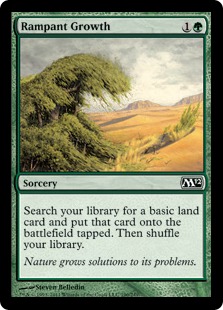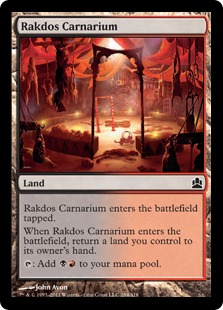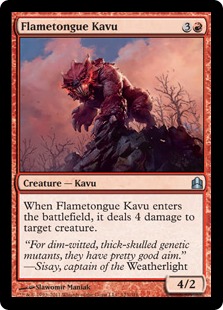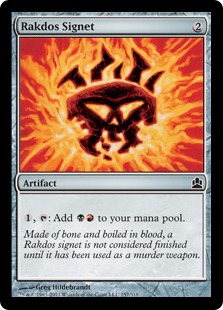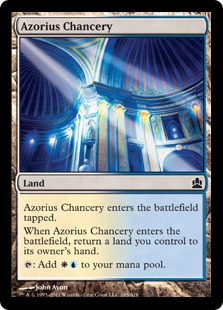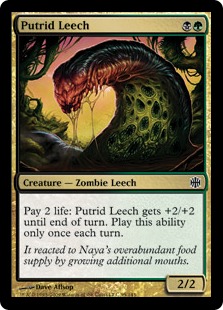In March of 2010, Tom LaPille posted on Twitter telling people to cut the Ravnica Signets and Karoos/bouncelands (Azorius Chancery, Gruul Turf, etc.) from their cubes.Â
“Signets put impossible pressure on green decks and attack decks. I’m less attached to axing the bouncelands, but I still like them gone.”
“Signets let midrange decks speed through early turns and non-green decks accelerate quickly, marginalizing attack and green decks.”
As one of the early authorities on cube, one who got hired at Wizards’ R&D mostly due to his knowledge of cube and applying that knowledge to set design, many cube designers followed Tom’s advice, with many of them holding onto the beliefs held in these tweets to the present day, taking the signets and bouncelands out of their cubes and keeping them out in order to help make aggressive decks and green decks more relevant.
In this article, I’ll discuss why this isn’t necessarily true. I’ll be discussing the talking points addressed by those who say that signet-less and bounceland-less cubes make for better cubes.
Point 1: Green’s marginalization
In cube, several of green’s historic strengths are unfortunately shared by other colors. While blue and red respectively have a near-monopoly of quality counterspells and burn, signets, bouncelands, “fast mana” (artifacts that create more mana than their cost—Mana Vault, Grim Monolith, the ABU Moxen, Mox Diamond, etc.), and “mana rocks” encroach on green’s naturally strong mana-fixing and mana acceleration. Another green aspect in the color pie is its having the best big creatures, yet all of the other colors and artifacts have very strong creature finishers. In fact, it’s pretty easy for a two-color green midrange or control deck to not have a single green creature that costs over five mana.
Taking signets and bouncelands out of a cube can help green to reclaim one of its historic strengths, as taking those cards out results in green having the lion’s share of mana fixing and mana acceleration. Granted, there are still many options available for mana accelerants (also known as “mana rocks”) like Mind Stone, Prismatic Lens, Everflowing Chalice, and the Mirrodin Talisman cycle (Talisman of Unity), but they don’t provide the same pain-free fixing and acceleration package that the signets do.
Does taking signets out of a cube force non-green decks to play fair and play their Wraths on turn 4 and their Dragons on turn 6? Not necessarily. Even when you take the signets out of your cube, non-green decks still have access to artifact-based mana acceleration through “mana rocks” like Everflowing Chalice, Mind Stone, the Talisman cycle, and other more broken artifacts like Mox Diamond.
Unlike the seldom-used Mirrodin Talisman cycle (Talisman of Unity), the signets give control decks pain-free access to mana fixing and acceleration, something not typically done at less than three mana (discounting Mox Diamond, which is just unfair). There are some upsides that the Talisman cycle provides, like allowing a UW deck to cast Swords to Plowshares or Preordain off of a turn 2 Talisman of Progress, but for the most part, Azorius Signet is better for UW cube control decks.
Despite the pain-free mana acceleration and fixing, those features don’t make those cards that much better than the other mana rocks. If a cube designer were to take out the signets, there would certainly be other artifact-based mana accelerants available for non-green decks like UW control.
When I had first heard the argument about green being weaker because of signets and bouncelands, I thought, “Why should I cut signets because they make cards like Rampant Growth look not good enough? Shouldn’t I just cut Rampant Growth because it’s not good enough?” Instead of using cards like Rampant Growth in my cube, I’ve only used the ones that I’ve considered to be better than the signets and the other mana rocks, as signets shouldn’t be taken out because they’re too good, but green mana acceleration and fixing should use signets as a benchmark because if a green fixer/accelerant isn’t as good as a signet, people aren’t going to use it.
For reference’s sake, these are the ones that I’m currently using that cost less than four mana:
Joraga Treespeaker, Llanowar Elves, Fyndhorn Elves, Noble Hierarch, Birds of Paradise, Rofellos, Llanowar Emissary, Sakura-Tribe Elder, Lotus Cobra, Cultivate, Kodama’s Reach, Harrow, and Yavimaya Elder.
Even if you think that some of the cards mentioned like Llanowar Elves are worse than the Signets, you’ll see from this list that green’s mana acceleration and fixing are far from obsolete from the introduction of Signets to the format. Green’s big creatures are unfortunately in an awkward position because there aren’t many that are good at the role of being big, beefy attackers like artifact creatures such as Wurmcoil Engine, Myr Battlesphere, and Sundering Titan. Instead, many of green’s ramp targets tend to be like Woodfall Primus and Terastodon—creatures with pretty large bodies but mainly used to deal with opposing permanents. Â
While green’s strengths are encroached upon in cube, like with mana fixing/acceleration, green still performs its strengths well. (A really powerful six-drop in green and/or some seven-plus-mana guys that do more than Rootgrapple things would be nice!) Â
Also, while green’s strategies lean towards midrange and ramping, it’s solid at supporting aggressive too—as green typically has the most one-drops of any color in cube. RG is one of the perennial aggro cube archetypes, but GW and GB are also solid at supporting aggressive strategies (as well as the more oft-seen midrange strategies that are bolstered by the ‘better-than-signet’ fixers/accelerants).
Green may have looked like it suffered from the introduction of powerful Ravnica fixers, but it was only the suboptimal green mana fixers/accelerants that did, and that’s only because they made the suboptimal fixers truly come to light.
Point 2: Aggressive decks’ marginalization
In my first article on cube about aggressive strategies and how to enable them in cube, I talked about how all cube cards (in a simplified manner) essentially break down into three categories:
Aggro: Cards like Steppe Lynx and Accorder Paladin — cards that are very solid in aggressive decks but aren’t good in control decks since they conflict with that strategy. (Control decks seek to win a long game; those cards are best in games that end ASAP by dealing damage quickly and efficiently.)
Control: Cards like Moat and Akroma, Angel of Wrath — cards that are very solid in control decks but are poor in aggro strategies since they conflict with that strategy. (Those cards are slow; aggro decks want to win ASAP.)
Universally Playable: Cards like Gideon Jura, Kor Sanctifiers, and Swords to Plowshares — cards that are great in both control and aggro archetypes as they supplement both strategies.
Note that this ignores combo, as dedicated combo decks don’t happen very often in cube. When they do happen, they tend to be used as subthemes to decks and are generally more on the side of general synergy than a full-blown combo deck (Karmic Guide, Reveillark, and Crystal Shard in a WU control deck).
While some decks like Julian Levin’s Boros aggro deck used Boros Garrison to cheat on land counts, many more midrange and control decks used it, like the Angelfire decks. The bouncelands generally perform that way in cube; they’re played much more often in midrange and control decks that can spare the loss of tempo for the gained card advantage. While aggro decks can use bouncelands, the bounceland cycle tends to lean more towards helping control decks than aggressive ones.
In that way, using the full cycle of bouncelands makes control decks stronger at the cost of aggressive decks. Signets are archetypically similar in that they’re mainly used in control decks, and using the full cycle adds more cards that are control-focused to your cube, but not anywhere near the amount needed to tilt your cube to one where aggressive strategies aren’t viable.
Four mana is an interesting spot in the cube mana curve, as it’s very different for both aggro and control decks: aggro decks tend to end their curve at or around this cost, seeking to end the game quickly after, but control decks tend to plan for their strategy to get its gears into motion at that same cost by casting a big spell to help themselves stabilize or gain a big advantage (Deep Analysis, Wrath of God, Garruk Wildspeaker, etc.).
Two-mana rocks like the signets and talismans favor control decks in that regard since, as Tom pointed out, those mana rocks help control decks get to that critical four-mana threshold quicker, without the aid of green, making it so they can cast something important like a Wrath of God on turn 3.
However, because of the loss of tempo provided, despite four mana also being a critical point in the aggro mana curve, a start that begins with a turn 2 or even a turn 3 signet is bad for aggro decks. This is since those decks typically want to end the game as quickly as possible, and spending two valuable mana in the early game to ramp mana isn’t as useful. Their plan is to end the game soon after or at least set into motion its plans for ending the game. This makes it so that signets and bouncelands in aggressive color pairs like RG and BR don’t get played nearly as much as their control counterparts (UW, BU) since Gruul Signet and Rakdos Signet pair poorly with aggressive strategies. They sometimes end up in the midrange/control variants of those color combinations or get used to enable splashes (BU splashing red for Flametongue Kavu off of a Rakdos Signet and Carnarium).
Aggressive strategies are weak in cubes, not because of powerful mana fixers, but because aggressive strategies aren’t well-supported. My article on supporting aggressive archetypes talks about how to adequately, and I did a podcast episode with my friend Anthony Avitollo about supporting aggro in cube as well as another with Anthony, aggro player extraordinaire Kenny Mayer, and Adam Prosak about what people generally do wrong in cube (with aggro support/drafting being one of the concepts.)
However, if that’s too much to listen to/click through, you generally want to ensure that your aggressive cards are at least twice the number of your control cards (and there’ll be a lot of universally playable ones) and to get your average mana cost as low as you can—less than three is a good starting goal for powered cubes, but when I last calculated mine, it was somewhere in the 2.6 area. Doing steps like these will do much more to support aggressive archetypes than taking the signets and bouncelands from being control-oriented cards.
When people were discussing Tom’s tweets and stance on using signets and bouncelands in cube, I was using all ten of the signets and none of the bouncelands (as I had no room for them, as they weren’t powerful enough) in my 450-card cube. I wanted to test the theory, so I hosted several drafts where I took all of the signets out of my cube and replaced them with other artifact mana-accelerants (Everflowing Chalice, Mind Stone, Prismatic Lens, Mirrodin Talisman cycle) and other miscellaneous artifacts that were in my on-deck binder like Chimeric Idol.
I told the drafters that I was doing some test drafts without signets, using mana rocks in their place (as well as other artifacts). The result was that not that much changed in the final decks. One interesting thing was that in every draft, there was always someone in monocolor (mono-white aggro, mono-blue control), which didn’t happen that frequently in my cube. However, aside from that, not very much had changed. Aggro didn’t suddenly become good and more relevant. The removal of signets didn’t shake the foundations of my cube, as the foundations were already solid—aggressive decks were good before, and they still were after. Control decks existed before, and the smart players shifted their strategy accordingly by putting cards like Mind Stone and Everflowing Chalice into their decks.
The appropriate amount of mana-fixing that should be in a cube is a difficult thing to weigh, as that threshold depends on the size of your cube, and it’s something that should be carefully monitored, but know that if you find that forcing 5-Color Control is a dominant archetype in your cube, it’s not the fault of signets/bouncelands.
One of the really interesting things about the cube designed for the 2007 Invitational was that they limited the available mana-fixing.
In an interview that Tom had with Aaron Forsythe on this very site:
“Another design goal that they had was to have their cube feel like a normal Limited environment in the sense that color commitments meant something. They knew that they were going to include utterly broken cards like Wheel of Fortune, Ancestral Recall, and Time Walk, but they didn’t want a situation where those cards would get taken by anyone who opened them and then splashed via strong non-basic land mana fixing. To them, picking Ancestral Recall shouldn’t a commitment to pick up a few blue nonbasic lands; it should mean that you are going to actually play blue.
To this end, they included very minimal amounts of mana fixing nonbasic lands. They started with only the cycle of Alpha dual lands and a few other individual standouts, but eventually added Ravnica’s Karoos because of how well they played. There were other individual lands like City of Brass, but no more cycles of lands. Aaron knew that he had succeeded when Stephen Menendian was faced with the first pick first pack choice of Time Walk against Dark Confidant, and ended up picking the Confidant because “Confidant is a better black card than Time Walk is a blue card.” I suggested to him that perhaps mana fixing has less of a distorting effect when there simply aren’t cards on the level of Time Walk to splash, which he thought was reasonable. He said that the amount of mana fixing in a cube is really a matter of taste in his opinion, but he was happy with how the Invitational cube felt.”
I don’t suggest cutting mana fixers to the extent that the Wizards 2007 Invitational cube did, but I can get behind the theory that drove it. Many of the best cards in cube are splashable: Ancestral Recall, Time Walk, Fact or Fiction, Flametongue Kavu, Mind Twist, Dark Confidant, Balance, Survival of the Fittest (to name a few). While I’m careful to monitor the amount of fixing in my cube, it’s still possible to see a card like Ancestral Recall or Time Walk in a pack and then start to look for fixers to accommodate the splash, while also making it so that people can’t ignore signals and get too greedy in splashing and drafting (someone tried splashing Jace, the Mind Sculptor in a GW deck in my cube and was surprised to find that didn’t work).
In my last article about cycles in cube, I talked about the guild system that is used for multicolor aligned cards like Stormbind, Kird Ape, Gruul Turf, and Raging Ravine. The guild system allows cube designers to lump multicolor cards, multicolor-aligned cards like Kird Ape and multicolor-aligned lands like Raging Ravine to be lumped into a single section. In a way, the guild system allows cube designers to have their cake and eat it too, because it allows cube designers to break up cycles to use the ones that work best for the color pairs. Control-based color pairs like UW get lands like Azorius Chancery, and color combinations that have deep multicolor options like BG get to use more multicolor cards like Putrid Leech and Spiritmonger.
An argument that’s used against it is that the guild system doesn’t provide even options for the color combinations. Those who argue against the guild system argue that giving UW Azorius Chancery and conversely giving BG Putrid Leech makes BG worse since color combinations like UW get better mana fixing while BG gets cards that are harder for the archetype to play due to their multicolor nature. Thus combinations like UW get more out of Azorius Chancery than BG gets out of Putrid Leech. While I’ve used the guild system for a while, there is merit to the argument.
Another idea that shores up that weakness of the guild system is to use the ‘wildcard’ land cycle so that you can still break up land cycles and use the best components for the color pairs Azorius Chancery would go into UW, as UW decks are generally slow control decks, whereas Karplusan Forest or Copperline Gorge would go into RG. RG decks are typically aggressive ones that want access to mana ASAP with little regard to life or the late game, feelings not shared by the average UW deck.
I’ve been tinkering with a system, a hybrid of the guild system and the wildcard system. Â
Each color combination gets an original ABU dual, a Ravnica “shockland,” and a fetchland and a ‘wildcard’ land (Celestial Colonnade, Creeping Tar Pit, Raging Ravine, Lavaclaw Reaches, Horizon Canopy, Llanowar Wastes, Simic Growth Chamber, Fetid Heath, Forge[/author]“]Battlefield [author name="Forge"]Forge[/author], and Izzet Boilerworks). Each color combination gets four multicolor cards, one of which may include a signet (Simic Signet, Azorius Signet, Izzet Signet, Dimir Signet, Orzhov Signet—to give UW/UB ways to easily splash the other color). If you’d like to see my current cube’s configuration, it’s in my cube list on my blog.
It’s not set in stone and may change if the ‘return to Ravnica’ gives cube designers some more powerful mana-fixing and acceleration options, but that system has been working out very well in my cube right now. I’ve used the guild system for my common cube. Even in that format, bouncelands like Rakdos Carnarium don’t make the cut, not because they’re too powerful for the format, but because they don’t bring enough to RB archetypes in my common cube.
However, if you’re a traditionalist and don’t want to break up land cycles, running the bouncelands and signets in complete cycles isn’t going to wreck your cube and make green and/or aggressive strategies irrelevant.
Conclusion:
I hope that this article has given you a new view on something that may have been seen as sacrosanct in your mind—the role of the powerful Ravnica mana fixers in cube. I’ve found that in my cube, those who have modeled their cube after mine have found that the bouncelands and signets don’t render aggressive decks and/or green decks irrelevant in cube. Using the guild system, I’ve found a way to include the signets and bouncelands that are best for my cube, but even if I were to use all ten of the signets and bouncelands (I probably wouldn’t use the bouncelands anyway, as I probably wouldn’t have room for them), my cube’s aggressive and green decks wouldn’t become irrelevant.
May all of your opening packs contain Sol Rings!
@UsmanTheRad on Twitter
My blog featuring my (powered and pauper) cube lists: http://idratherbecubing.wordpress.com
Cube podcast that I and Anthony Avitollo co-host: The Third Power

